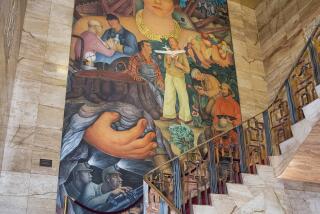Sifting Through Sands of Time for the Truth About Sheba
- Share via
“A modern Indiana Jones,” a Times reviewer said of Nicholas Clapp’s last book, “The Road to Ubar,” in which the Los Angeles-based filmmaker and archeology lecturer described the search for a fabled Arabian city that had flourished by trading in frankincense. Long buried by the sands of the peninsula’s arid “Empty Quarter,” a vast desert, Ubar was located with the aid of satellite imagery that revealed a web of ancient caravan routes.
“Sheba” is just as readable. According to Clapp, his search for a historical basis for the legend of the queen who, in the Old Testament Book of Kings, journeyed to Solomon’s Jerusalem, her camel train loaded with treasure, involved a lot more than dusting off potsherds and tracing inscriptions.
Clapp rode “the worst train in the world” from the interior of Ethiopia to the Red Sea. The dhow on which he sailed to Yemen nearly capsized in a storm. His investigations of the ancient realm of Saba (Sheba) were constantly endangered by Yemeni tribal warfare. Beyond every turn in the road lurked militiamen chewing narcotic qat leaves and brandishing Kalashnikovs. His first attempt to see the ruins of Sirwah, the Sabean rulers’ summer retreat in the mountains, had to be called off because Yemen’s air force was bombing it.
But there’s more to this book than adventure stories and vivid descriptions of the Middle East and Africa. It makes a significant contribution to the scholarly debate about whether the queen of Sheba existed--and whether Solomon was the great king of the Bible, a minor hill-country chieftain or a myth concocted by Israelites newly returned from Babylonian exile, and in need of a grand and coherent national story.
If there was a queen, and she did visit Solomon, it happened about 950 BC. But excavations around Jerusalem show nothing of the building boom attributed to Solomon (and Arab-Israeli tensions have kept key sites such as the Temple Mount off-limits). The kingdom of Saba, archeologists long believed, didn’t flower until about 600 BC--too late to support the Sheba legend.
This view has recently changed, Clapp says. Saba is now credited with a rich agriculture and international trade as long ago as 1200 BC. He describes the ruins of Ma’rib, where Yemen’s mountains meet the desert: remnants of a 2,000-foot-wide Great Dam that tamed flash floods for 1,300 years before it collapsed about 615 AD; irrigation channels for 20 miles of fields and gardens; a huge, enigmatic oval temple complex, the Mahram Bilqis (Bilqis being the alleged queen’s given name), whose buried necropolises have yet to be explored.
The appeal of archeology has always been that it brings the dead to life. Clapp makes us admire the vision and ingenuity of these long-ago people, just as he astounds us with descriptions of Coptic Christian churches in Ethiopia, which traces its royal lineage to Menelik, the son of Solomon and Sheba. The builders dug doughnut-shaped pits into bedrock and sculpted each church in one piece, with immense labor, from the rock left standing.
A powerful myth--if it was a myth--to inspire such devotion. Clapp shows how the queen of Sheba got incorporated into Christian thinking. Some medieval European writers viewed her as a foreteller of Christ’s coming, even as one who, standing beside him, would judge souls at the world’s end. She inspired Renaissance alchemists and figured in demonic Lilith stories. Almost for fun, Clapp goes on to record the queen’s incarnations in Viennese opera, Hollywood movies and a Death Valley lead mine.
Under so many overlays of fiction, can any reality be discerned? Clapp admits that he found no direct proof of the queen’s existence. But, he says, with Sabean “civilization coming into focus, the biblical account of Sheba and Solomon assumes the markings of a real event and by association gives Solomon credibility as a historical figure.”
More to Read
Sign up for our Book Club newsletter
Get the latest news, events and more from the Los Angeles Times Book Club, and help us get L.A. reading and talking.
You may occasionally receive promotional content from the Los Angeles Times.










